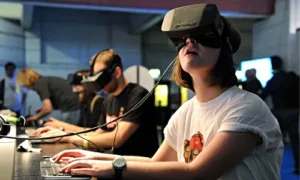The Korea University College of Medicine in Seoul presented the results of the first ever study (reported by Healio Ocular Surgery News and published in the Journal of Pediatric Ophthalmology and Strabismus) on the effects of head mounted displays on human vision. In their study they had 60 volunteers in the age group from 13 to 18 years watch either a 3D movie or try a virtual reality experience. After 30 minutes of watching they did not observe any change in spherical equivalent, near point of accommodation and stereo acuity. They did however observe transient myopic shifts of 17.2% to 30% in both the virtual reality and three-dimensional movie viewers. In no case did this last more than 40 minutes.
Sourde: Oculus
They also found a very slight esopheric shift (crossed eyes) directly after watching the head mounted displays.
Interestingly, one participant of the 60 had to be excluded as he experienced motion sickness and nausea.
The authors concluded “There were no significant clinical effects on normal adolescent eyes with 30 minutes of watching the head-mounted display. Although transient changes in refractive error and esodeviation in a few participants after watching the head-mounted display were found, the changes were not significant.”
Analyst Comment
Here we have the first study on the effects of virtual reality on the eye. While the study is not differentiating between augmented and virtual reality headsets (well there are no augmented reality headsets with see through technology in wide distribution today) the effects of virtual content is more important at the moment, anyway. Before we can assess the effects of VR on a wider group of people we need headsets and content to use in the test. That’s a typical chicken and egg problem.
From an observer’s perspective, I have a few comments about this study. The group of participants was relatively young. Younger eyes adapt much faster to viewing and light changes than older eyes, so does this play a role in how older people will react to AR/VR? There is no mention of whether all of the participants had perfect vision to start with or not. I would like to see if there is a difference for people with vision defects versus people with perfect vision in using head mounted displays.
Then there is the question of the usage time. 30 min is not really a long usage time when we consider gaming and 360 degree movies as a basis. This is even more pronounced if we consider the usage of VR and AR in the business field. We would be looking at usage times of several hours. Does this change the results?
The one consequence the study points out is a ‘transient myopic shift’ in some participants. Does this mean that users of VR headsets should not operate machinery and especially do not drive cars immediately after using such technology? Now this also raises the question if the same issue arises for AR headsets. Here some suggest to use AR while driving, which would be not a good if this is true. (NH)
Tests that were reported at the 3IT event in September 2015 (AR Needs Touch and Short Sessions) when the CEO of Vectorform in Germany reported that users of VR and AR found it hard to concentrate beyond 20 minutes and that exposure of up to six hours (!) led to staff experiencing symptoms close to jet lag. There’s clearly more work to be done. (BR)

